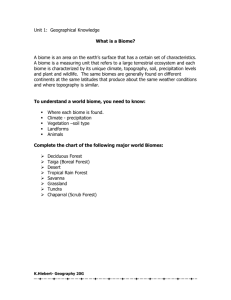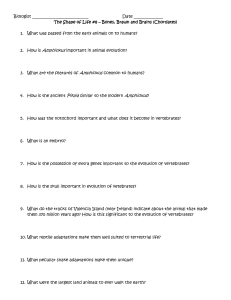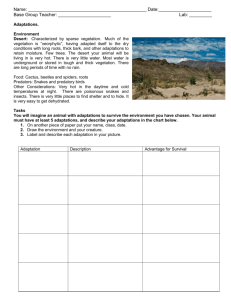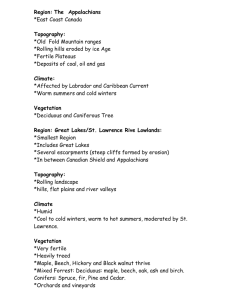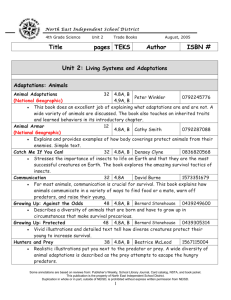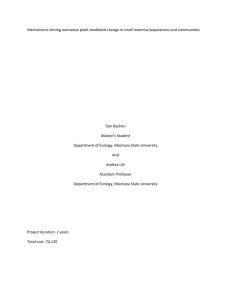Deciduous Forest relatively warm summers and relatively cold
advertisement
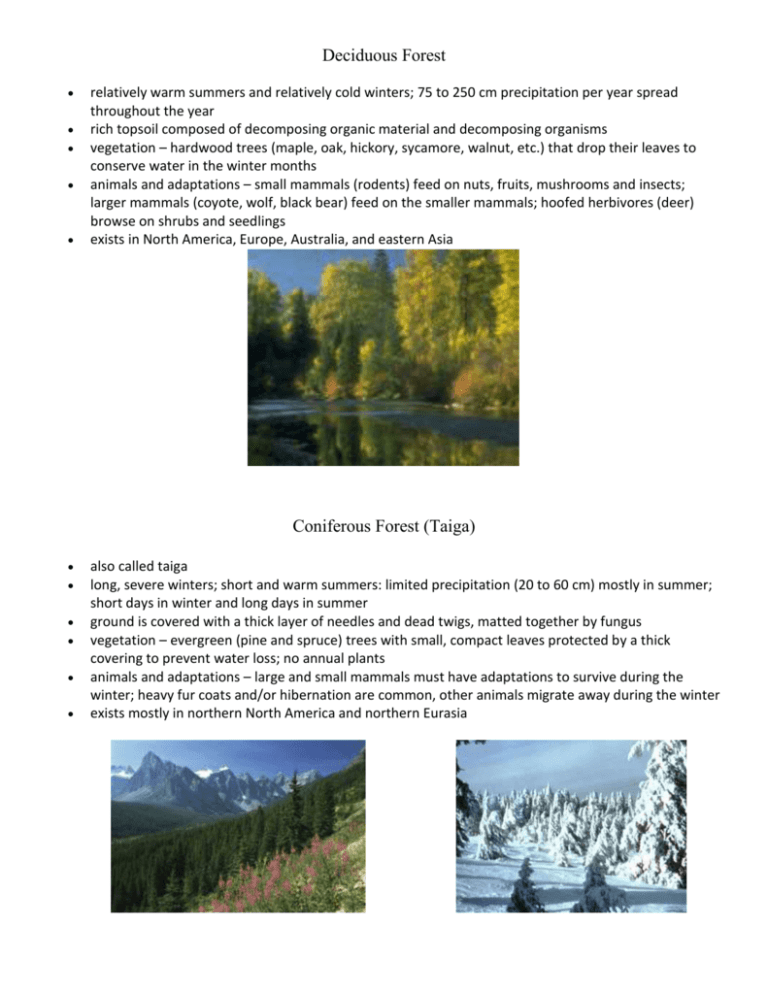
Deciduous Forest relatively warm summers and relatively cold winters; 75 to 250 cm precipitation per year spread throughout the year rich topsoil composed of decomposing organic material and decomposing organisms vegetation – hardwood trees (maple, oak, hickory, sycamore, walnut, etc.) that drop their leaves to conserve water in the winter months animals and adaptations – small mammals (rodents) feed on nuts, fruits, mushrooms and insects; larger mammals (coyote, wolf, black bear) feed on the smaller mammals; hoofed herbivores (deer) browse on shrubs and seedlings exists in North America, Europe, Australia, and eastern Asia Coniferous Forest (Taiga) also called taiga long, severe winters; short and warm summers: limited precipitation (20 to 60 cm) mostly in summer; short days in winter and long days in summer ground is covered with a thick layer of needles and dead twigs, matted together by fungus vegetation – evergreen (pine and spruce) trees with small, compact leaves protected by a thick covering to prevent water loss; no annual plants animals and adaptations – large and small mammals must have adaptations to survive during the winter; heavy fur coats and/or hibernation are common, other animals migrate away during the winter exists mostly in northern North America and northern Eurasia Tundra covers a fifth of the earth’s land surface, little precipitation (less than 25 cm per year), less than one meter down the ground is permanently frozen (permafrost) boggy in summer when ground thaws since permafrost does not allow water to drain; annual flowers and grasses grow quickly in the short summer; bitterly cold most of the year; long winter, very short summer period of time when there is no sunlight and corresponding period when there is no night; drying winter winds vegetation – virtually treeless because of permafrost, dominated by herbaceous plants, mosses and lichens, all of which grow close to the ground to help them survive icy winds animals and adaptations – large hoofed mammals (caribou and reindeer), small rodents, and some predators (arctic fox, polar bears), during 2 months of summer migratory birds (geese) exists in a continuous belt across northern North America, Europe, and Asia and at the top of mountains Tropical Rain Forest richest biome in terms of numbers of species it is estimated that they contain at least half of the world’s land organisms; rainfall of 200 to 450 centimeters per year, with little difference throughout the year; length of the day varies by less than one hour the soil is quite infertile because the nutrients from any fallen organic matter are quickly extracted by the roots of vegetation that are spread out in the top-most layer of soil vegetation - tall trees with smooth bark and no under branches form high canopy of large, leathery leaves; inconspicuous flowers; trees have large, thick bases to anchor themselves; long, woody vines appear in any open spaces; epiphytes, plants that grow on other plants, are abundant, getting their water and minerals from the humid air; other plants are ferns, orchids, mosses, and bromeliads adapted to grow at low light intensities animals and adaptations – large numbers of insects and tree-living vertebrates including birds, primates, large and small mammals and reptiles exists in South America in and around the Amazon Basin, in West Africa and in Southeast Asia, and equatorial regions Desert less than 25 cm of rainfall per year, but highly variable each year; occur between 20º to 30º north and south latitude; warm days but cold nights vegetation – mostly annuals that can go from seed to flower in the short period of time when water is present; perennials (cactus and other succulents) are adapted for water storage with no leaves or leaves that fall off during drought, or leaves that are small and leathery; all have extensive root systems that can trap water during periods when it is available animals and adaptations – reptiles and insects have waterproof outer coverings and water-conserving excretions; mammals are nocturnal with the ability to extract water from plants exists in the interiors of continents, especially Africa, Eurasia, and Australia Grassland rich agricultural lands; periodic droughts, hot-cold seasons, rolling flat terrain, 10 to 60 cm of rain per year, warm and wet spring followed by scorching, dry summers, cold and snowy winters vegetation – mostly sod-forming grasses mixed with legumes and various annuals animals and adaptations – small, seed-eating rodents, large herbivores (bison), and carnivores (coyote, wolves) exists in North America (plains and prairies), Russia (steppes), South Africa (veldt), and Argentina (pampas)

